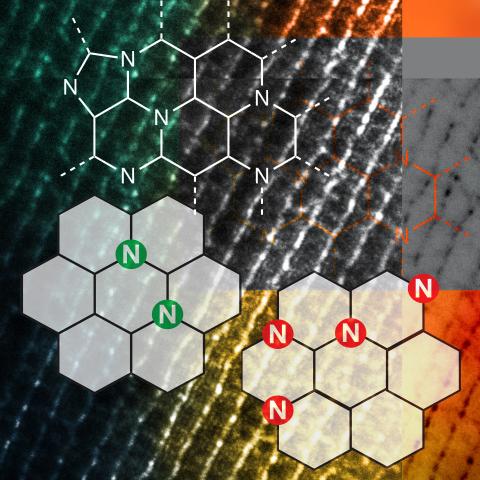
via Ames Laboratory
Scientists at the U.S. Department of Energy’s Ames Laboratory have discovered a metal-free carbon-based catalyst that has the potential to be much less expensive and more efficient for many industrial concerns, including manufacturing of bio- and fossil fuels, electrocatalysis, and fuel cells.
At their most fundamental, these industry processes involve splitting strong chemical bonds, like hydrogen-hydrogen, carbon-oxygen, and carbon-hydrogen bonds. Traditionally this has been accomplished with catalysts that use transition or precious metals, many of them expensive and low in natural abundance — like platinum and palladium.
The scientists performed experiments with a type of heterogeneous catalyst, Nitrogen-Assembly Carbons (NACs), in which the design and placement of nitrogen on the carbon surface greatly influenced the catalytic activity of the material. These N atoms on carbon surfaces were previously believed to be distant from one another, as the close placement of N atoms is thermodynamically unstable. The team in Ames Lab correlated the N precursors and pyrolysis temperature for the NACs synthesis with the N distribution and discovered that meta-stable N assemblies can be made by design and deliver unexpected catalytic reactions. Such reactions include hydrogenolysis of aryl ethers, dehydrogenation of ethylbenzene and tetrahydroquinoline, and hydrogenation of common unsaturated functionalities (such as ketone, alkene, alkyne, and nitro groups). Moreover, the NACs catalysts are robust with consistent selectivity and activity for both liquid and gas phase reactions under high temperature and/or pressure.
“We discovered that how the nitrogen was distributed on the surface of these NACs really mattered, and in the process realized that this was an entirely new kind of chemical activity,” said Ames Laboratory Associate Scientist Long Qi.
“The discovery should enable scientists to design nitrogen assemblies that are able to accomplish more sophisticated and challenging chemical transformations without the need for transition metals” said Ames Laboratory scientist Wenyu Huang. “It broadly applies to many different types of chemical conversions and industries.”
The Latest Updates from Bing News & Google News
Go deeper with Bing News on:
Chemical manufacturing
- US may ban chemical used to make decaf coffee, but there are alternatives: What to know
Start the day smarter. Get all the news you need in your inbox each morning. However, coffee consumers are exposed to an exceedingly low amount of the chemical. Currently, the ...
- CORRECTING and REPLACING Dairen Chemical Corporation Joins The LYCRA Company and Qore® in the Development of Renewable LYCRA® fiber
Steve Stewart, chief brand and innovation officer, The LYCRA Company, and Shean-Tung Lin, Chairman, Dairen Chemical Corporation (DCC), sign a letter of intent for D ...
- Superfund/CERCLA Chemical Taxes: Trade Associations' Letter to Internal Revenue Service Addressing Refund Issue
The specific issue is described as follows: . . . many companies are exporters of chemical and chemical derivatives to foreign customers that do not pay taxes in the United States. When these ...
- A low-energy process for high-performance solar cells could simplify the manufacturing process
Finding reliable, eco-friendly power sources is crucial as our world grapples with increasing energy needs and the urgent call to combat climate change. Solar energy offers one solution, with ...
- Merak Ventures leads seed funding for Atomgrid, a specialty chemical manufacturing platform
Merak Ventures invests Rs 10 crore in Atomgrid, alongside other VCs. Co-founded by IIT-BHU alumni, Atomgrid aims to enhance R&D, global outreach, and ...
Go deeper with Google Headlines on:
Chemical manufacturing
[google_news title=”” keyword=”chemical manufacturing” num_posts=”5″ blurb_length=”0″ show_thumb=”left”]
Go deeper with Bing News on:
Metal-free carbon-based catalyst
- Scientists unlock key to cheap hydrogen fuel with 95% less iridium
R esearchers from the RIKEN Center for Sustainable Resource Science (CSRS) in Japan may have found the secret sauce to cheap hydrogen fuel production. The secret, it seems, could be to mix a little ...
- New Sugar-Based Catalyst Upcycles Carbon Dioxide
A new catalyst made from an inexpensive, abundant metal and common table sugar has the power to destroy carbon dioxide (CO 2) gas. In a new Northwestern University study, the catalyst successfully ...
- New sugar-based catalyst could offer a potential solution for using captured carbon
A new catalyst made from an inexpensive, abundant metal and common table sugar has the power to destroy carbon dioxide (CO2) gas.
- Trash To Treasure: Researchers Turn Metal Waste Into Catalyst for Green Hydrogen
Scientists have found a way to transform metal waste into a highly efficient catalyst to make hydrogen from water ... The group is partnering with AqSorption Ltd, a Nottingham-based company ...
- Researchers turn metal waste into catalyst for hydrogen
(Nanowerk News) Scientists have found a way to transform metal waste into a highly efficient catalyst to make hydrogen from water ... The group is partnering with AqSorption Ltd, a Nottingham-based ...
Go deeper with Google Headlines on:
Metal-free carbon-based catalyst
[google_news title=”” keyword=”metal-free carbon-based catalyst” num_posts=”5″ blurb_length=”0″ show_thumb=”left”]










